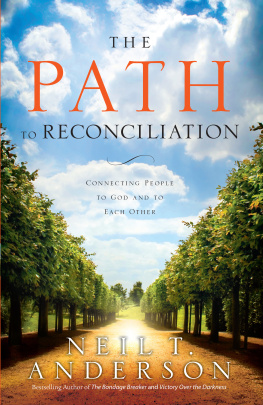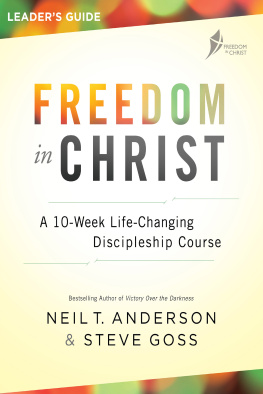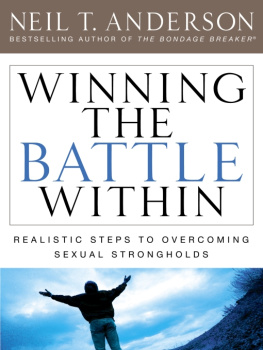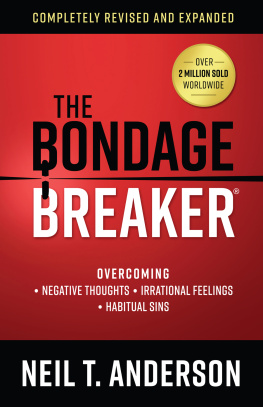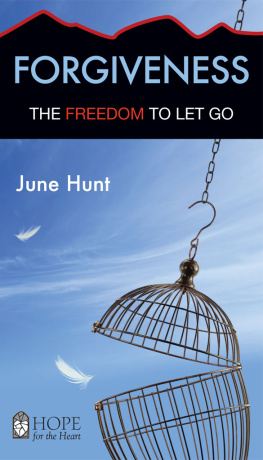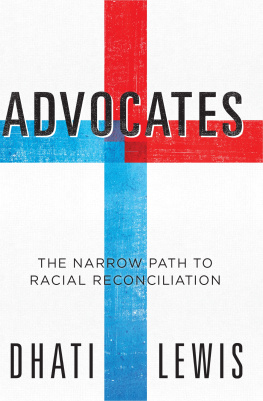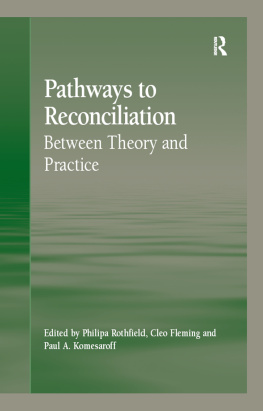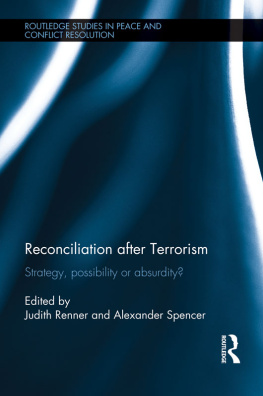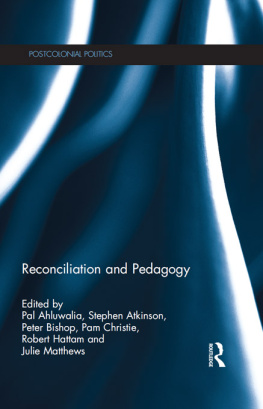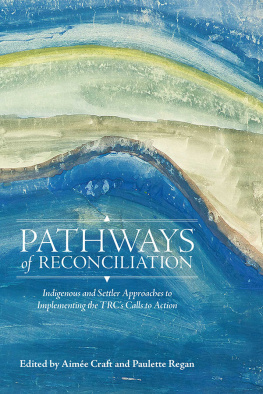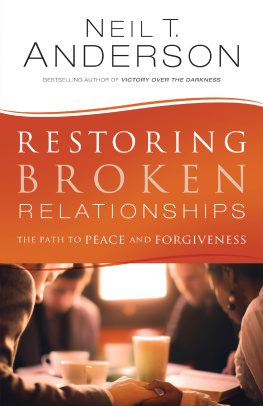
2008 Neil T. Anderson
Published by Bethany House Publishers
11400 Hampshire Avenue South
Bloomington, Minnesota 55438
www.bethanyhouse.com
Bethany House Publishers is a division of
Baker Publishing Group, Grand Rapids, Michigan.
www.bakerpublishinggroup.com
Bethany House Publishers edition published 2014
ISBN 978-1-4412-6560-9
Previously published by Regal Books
Ebook edition originally created 2011
All rights reserved. No part of this publication may be reproduced, stored in a retrieval system, or transmitted in any form or by any meansfor example, electronic, photocopy, recordingwithout the prior written permission of the publisher. The only exception is brief quotations in printed reviews.
Library of Congress Cataloging-in-Publication Data is on file at the Library of Congress, Washington, DC.
All Scripture quotations, unless otherwise indicated, are taken from the Holy Bible, New International Version. Copyright 1973, 1978, 1984 by International Bible Society. Used by permission of Zondervan Publishing House. All rights reserved.
Other version used is: NASBScripture taken from the New American Standard Bible, 1960, 1962, 1963, 1968, 1971, 1972, 1973, 1975, 1977 by The Lockman Foundation. Used by permission.
Portions of this book were originally published as Blessed Are the Peacemakers, 2002 Neil T. Anderson and Charles Mylander.
CONTENTS

CHAPTER 1
Jesus the Reconciler
CHAPTER 2
New Life in Christ
CHAPTER 3
The Great Schism
CHAPTER 4
The Ministry of Reconciliation
CHAPTER 5
Removing the Barriers to Reconciliation
CHAPTER 6
One New Man
CHAPTER 7
The Heart of Reconciliation
CHAPTER 8
Loving the Unlovely
APPENDIX A
Steps Toward Biblical Reconciliation with One Another
APPENDIX B
Starting a Freedom Ministry in Your Church
INTRODUCTION

In 1980, Christine Tolbert witnessed the brutal assassination of her father. President Tolbert and 16 members of his cabinet were tied up and then machine gunned to death by a group of drunken soldiers. The residents wife and her family were put under house arrest, but they eventually fled to Abidjan, Ivory Coast. For the next 15 years, Liberia struggled with tribal wars.
Christine married Lawrence Norman and began attending a Bible study led by Ron and Doris Weeks, two veteran Navigator missionaries. It was during this Bible study that they were introduced to the material of Freedom in Christ Ministries. Agonizing over her past, Christine struggled with how to forgive those who had killed her father and how to bring the ministry of reconciliation to the citizens of her war-torn country. At the same time, the political and military leaders of Liberia had come to the conclusion that they could not solve their problems politically or militarily. Somehow, they reasoned, the Church needed to be involved. Christine was convinced that the message and method of Freedom in Christ Ministries (FICM) could help the people of her country overcome their turbulent past and be reconciled to each other.
In the summer of 1995, the office of FICM received an urgent call from Ron and Doris Weeks, asking me if I could come to Liberia and facilitate some meetings with the leadership of this once-proud nation. Although I was more than willing to go, I knew that I wasnt the one who should respond to this call. Our international director at that time had been a missionary in Africa and he and his wife knew the culture, as well as the message and methods of FICM.
Abandoning their plans for summer vacation, they scrambled to update passports, obtain visas and arrange flights on Air Afrique. Five minutes before they arrived at JFK airport in New York, passports and visas were delivered to the ticket counter by representatives from the U.S. State department. Arriving in Abidjan, they were greeted by the Normans and 15 other Christian leaders with whom they would be living and working for the next week. The following morning they left for Monrovia, Liberia, a city that was now home to more than one million refugees seeking asylum and benefiting from aid offered through the United Nations relief organizations.
On the way to their destination, Hotel Africa, the FICM team was stopped every half-mile at checkpoints manned by the West African Peace Keeping Force (ECOMOG). But eventually they reached the hotel, which had originally been built to facilitate annual meetings of all the presidents of Africas territories. The coup in 1980 had prevented the facility from ever being used for its original purpose, and it had not been well maintained.
Upon the FICM teams arrival, the ECOMOG soldiers searched their luggage for weaponsthe hotel had been taken over by five warring factions who now occupied five of the six floors, and the peacekeeping force was trying to limit proliferation of arms. By now the group of Christian leaders had swelled to 25 as they settled in for communal living on the fourth floor. The rainy season ensured them plenty of fresh water, which unfortunately came directly into their room through holes in the walls and ceilings. Most of the carpet had molded away, but what remained had a pungent scent unique to Africa. Rats had taken up residence in their twin beds.
The first two days were spent preparing the Christian leaders to assist in the reconciliation process and to equip them for necessary follow-up. On Saturday morning, August 19, 1995, 100 dignitaries arrivedamong them were members of the media, educators, politicians and representatives of various community groups. The group was led through a process of personal repentance using the Steps to Freedom in Christ. Why? Because reconciliation is impossible without repentance. In addition, in order to affect any lasting change, the process of reconciling any group of people with each other must begin with those who provide the leadership. In this particular instance, the Holy Spirit brought conviction as each leader came to terms with his or her own compliance or complacency when it came to the atrocities that had taken place in Liberia.
This remarkable event sowed a seed that has continued to flower. Although Liberias problems did not immediately cease on that day in 1995, reconciliation is considered one of most urgent priorities by the countrys current government. As one of her first official acts in office, President Ellen Johnson-Sirleaf established a Truth and Reconciliation Commission to continue the work begun in the mid-1990s. Christine Norman continues to be a catalyst for forgiveness, repentance and reconciliation. Although she is currently recovering from cancer in the United States, she has appointed Luther Tarpeh to oversee the continuing ministry in Liberia. We recently received the following report from Luther that illustrates what one little seed sown many years ago can produce:
The Lord is blessing the work [of Freedom in Christ Ministries in Liberia] and we have become partners with almost all the big denominations. For instance, the Bishop of the Episcopal Church approved that all his priests must all go through the Steps to Freedom in Christ.
In August 2007, I am visiting the second largest Anglican church in Liberia to take the entire church of about 1,000 members through the Steps to Freedom. There are two senior government officials in this church.
Next page
